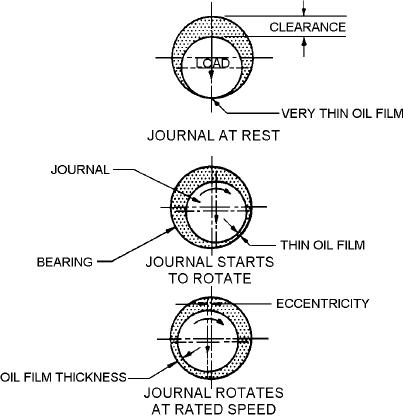
system constantly feeds oil to the bearing. The oil
bearings, the upper bearing half is installed in the
enters through the oil hole (fig. 3-58) and fills the oil
counter bore in the cylinder block. The lower bearing
groove in the bearing. From there, the rotating journal
half is held in place by the bearing cap (refer back to
carries the oil around to all parts of the bearing. The oil
figure 3-16). On connecting-rod bearings, the upper
works its way to the outer edges of the bearing. From
bearing half is installed in the rod and the lower half is
there, it is thrown off and drops back into the oil pan.
placed in the rod cap (refer back to figure 3-25). The
The oil thrown off helps lubricate other engine parts,
small-end (or piston-pin) bearing in the connecting rod
such as the cylinder walls, pistons, and piston rings.
is of the full round, or bushing type.
As the oil moves across the faces of the bearings, it
The main bearings in most engines do not have the
not only lubricates them but also helps to cool them.
oil distributing grooves as shown in figure 3-58. They
The oil is relatively cool as it leaves the oil pan. It picks
may or may not have the annular grooves; many
up heat in its passage through the bearing. This heat is
engines do not. On other engines, only the upper halves
then carried down to the oil pan and released to the air
of the main bearings have them. On still other engines,
passing around the oil pan. The oil also flushes and
both the upper and lower main-bearing halves have the
cleans the bearings. It tends to flush out particles of grit
annular grooves. Connecting rod, big-end bearings
and dirt that may have worked into the bearing. The
usually do not have oil grooves.
particles are carried back to the oil pan by the
The typical bearing half is made of a steel or bronze
circulating oil. They then tend to drop to the bottom of
back to which a lining of bearing material is applied.
the oil pan or are removed from the oil by the oil screen
(See fig. 3-58.) The bearing material is relatively soft.
or filter. The greater the oil clearance (fig. 3-59), the
Thus, if wear takes place, it will be the bearing rather
faster the oil will flow through the bearing.
than the more expensive engine part that wears. Then,
Thus, as bearings wear, more and more oil is
the bearing, rather than the engine part, can be replaced
thrown onto the cylinder walls. The piston rings cannot
when wear has progressed to the replacement point.
handle an excessive amount of oil; part of it works up
BEARING LUBRICATION.--The journal must
into the combustion chambers, where it burns and
be smaller in diameter than the bearing so there will be
forms carbon. Resulting carbon accumulation in the
clearance (called oil clearance) between the two parts;
combustion chambers reduces engine power and causes
oil circulates through this clearance. The lubricating
other engine troubles. Excessive bearing oil clearances
ASf03059
Figure 3-59.--Oil clearance between bearing and shaft.
3-40

